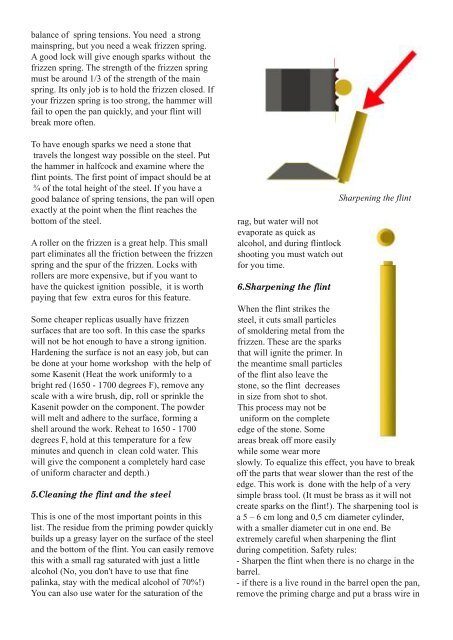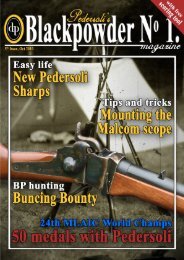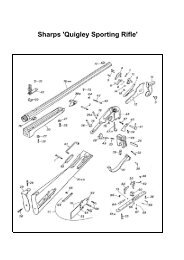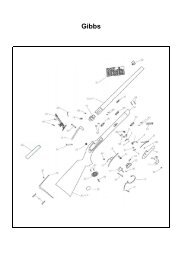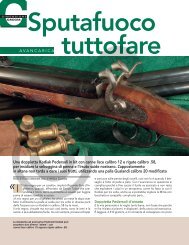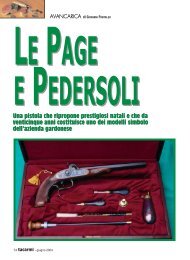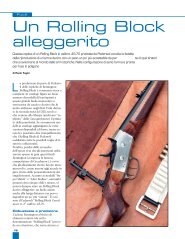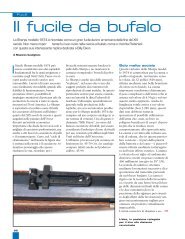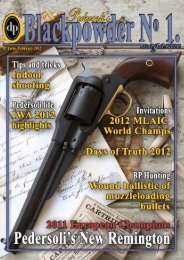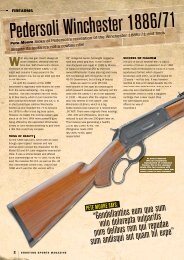You also want an ePaper? Increase the reach of your titles
YUMPU automatically turns print PDFs into web optimized ePapers that Google loves.
alance of spring tensions. You need a strong<br />
mainspring, but you need a weak frizzen spring.<br />
A good lock will give enough sparks without the<br />
frizzen spring. The strength of the frizzen spring<br />
must be around 1/3 of the strength of the main<br />
spring. Its only job is to hold the frizzen closed. If<br />
your frizzen spring is too strong, the hammer will<br />
fail to open the pan quickly, and your flint will<br />
break more often.<br />
To have enough sparks we need a stone that<br />
travels the longest way possible on the steel. Put<br />
the hammer in halfcock and examine where the<br />
flint points. The first point of impact should be at<br />
¾ of the total height of the steel. If you have a<br />
good balance of spring tensions, the pan will open<br />
exactly at the point when the flint reaches the<br />
bottom of the steel.<br />
A roller on the frizzen is a great help. This small<br />
part eliminates all the friction between the frizzen<br />
spring and the spur of the frizzen. Locks with<br />
rollers are more expensive, but if you want to<br />
have the quickest ignition possible, it is worth<br />
paying that few extra euros for <strong>this</strong> feature.<br />
Some cheaper replicas usually have frizzen<br />
surfaces that are too soft. <strong>In</strong> <strong>this</strong> case the sparks<br />
will not be hot enough to have a strong ignition.<br />
Hardening the surface is not an easy job, but can<br />
be done at your home workshop with the help of<br />
some Kasenit (Heat the work uniformly to a<br />
bright red (1650 - 1700 degrees F), remove any<br />
scale with a wire brush, dip, roll or sprinkle the<br />
Kasenit powder on the component. The powder<br />
will melt and adhere to the surface, forming a<br />
shell around the work. Reheat to 1650 - 1700<br />
degrees F, hold at <strong>this</strong> temperature for a few<br />
minutes and quench in clean cold water. This<br />
will give the component a completely hard case<br />
of uniform character and depth.)<br />
5.Cleaning the flint and the steel<br />
This is one of the most important points in <strong>this</strong><br />
list. The residue from the priming powder quickly<br />
builds up a greasy layer on the surface of the steel<br />
and the bottom of the flint. You can easily remove<br />
<strong>this</strong> with a small rag saturated with just a little<br />
alcohol (No, you don't have to use that fine<br />
palinka, stay with the medical alcohol of 70%!)<br />
You can also use water for the saturation of the<br />
rag, but water will not<br />
evaporate as quick as<br />
alcohol, and during flintlock<br />
shooting you must watch out<br />
for you time.<br />
6.Sharpening the flint<br />
Sharpening the flint<br />
When the flint strikes the<br />
steel, it cuts small particles<br />
of smoldering metal from the<br />
frizzen. These are the sparks<br />
that will ignite the primer. <strong>In</strong><br />
the meantime small particles<br />
of the flint also leave the<br />
stone, so the flint decreases<br />
in size from shot to shot.<br />
This process may not be<br />
uniform on the complete<br />
edge of the stone. Some<br />
areas break off more easily<br />
while some wear more<br />
slowly. To equalize <strong>this</strong> effect, you have to break<br />
off the parts that wear slower than the rest of the<br />
edge. This work is done with the help of a very<br />
simple brass tool. (It must be brass as it will not<br />
create sparks on the flint!). The sharpening tool is<br />
a 5 – 6 cm long and 0,5 cm diameter cylinder,<br />
with a smaller diameter cut in one end. Be<br />
extremely careful when sharpening the flint<br />
during competition. Safety rules:<br />
- Sharpen the flint when there is no charge in the<br />
barrel.<br />
- if there is a live round in the barrel open the pan,<br />
remove the priming charge and put a brass wire in


